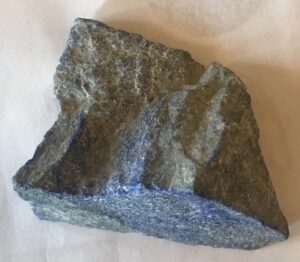Art Adventure • 6.24.2023 • Lapis Lazuli

Lapis lazuli. Red ochre. Yellow ochre. As a landscape painter I have long been fascinated by the fact that until recently most of the pigments with which artists painted landscapes came from the earth—from the landscape itself.
I applied for a grant with a really simple idea: Collect natural materials, grind them up to create pigments, process the pigments into oil paint and use it to depict landscapes. Neanderthals used red ochre in their burials a quarter million years ago. Roughly 17,000 years ago, Homo sapiens were using ochres to create the extraordinary cave paintings of Lascaux. The oldest known cave paintings depicting animals date from about 45,000 years ago in Indonesia. It’s not rocket science.
First lesson: Do not underestimate your forebears’ achievements. It’s more difficult than it seems.
My plan had been to take a weekend workshop in New Mexico thanks to the Art Adventure grant awarded me by the Newburyport Art Association and the Hemphill Family Foundation. But on reflection it did not make sense to spend three-quarters of the grant to travel for a workshop where I would learn to collect and process materials to which I would not have on-going access.
Second lesson: Remember the pandemic changed everything—including the cost of air travel.
So where, literally, to begin? The beach, the forest, the marsh, city parks, old mines? And what exactly am I trying to find? What does it look like in the wild? Do you dig it up or find it on the surface? Is it rocky or powdery? What color is it? Thus began a month of research that led to dozens more questions: inorganic vs. organic pigments? Natural vs. synthetic? Is it a dye or a pigment? Can you make pigments from organic materials? What is hematite? Limonite? Iron oxide? Ochre? I ordered books. I bought samples of pigments from around the world. In a burst of optimism that I would eventually figure it out, I purchased a mortar and pestle, a strainer, and a glass plate for mulling—for mulling? I found I did not have the vocabulary or background to really understand, much less retain or explain to anyone else, what I was reading.
Third lesson: If you don’t know what you’re talking about, do what teachers have been making students do for generations. Look up the vocabulary and write out (or if you’re giving yourself some leeway here, copy and paste) the definitions.
That’s what I did today. Then I headed over to the Harvard Museum of Natural History where I hoped they had examples of ochre in its natural state that I could photograph and add to my cheat sheet. They don’t. It turns out there are 4,800 different species (species?) of minerals, and Harvard seems to have focused on the most dramatic ones for its public display.
At the museum, I did purchase a small piece of lapis lazuli because it is rare in North America. The now-closed Blue Wrinkle Mine in Colorado yielded gem-quality lapis in the mid- to late-1900s, and there is some in San Bernadino County in California, which was until the 1939 Blue Wrinkle discovery the only source in North America, according to a 1938 article in American Minerologist. Lapis, which has been processed for pigment for at least six millennia, is grey in its natural state, and it’s really hard. Extracting the pigment is difficult; the multi-step rosin-beeswax process still sometimes used today was described by the 15th century painter Cennino Cennini in his “Book of Arts.” But I digress.
Fourth lesson: Focus.
For my next installment, I’ll focus on ochre, softer than lapis and I hope much easier to find, but that remains to be seen.